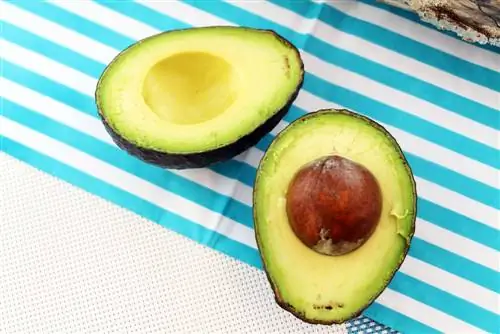- Author admin [email protected].
- Public 2023-12-17 03:39.
- Last modified 2025-01-24 12:45.
Strawberry lovers are particularly happy in May, because that's when the strawberry season starts in local regions. The red fruits not only taste particularly sweet, but are also extremely he althy. They are also incredibly low in calories, which is why they are also suitable as a sweet snack when dieting. On top of that, strawberries are real vitamin bombs and are also rich in a number of minerals and trace elements.
Nutritional values
The strawberries consist of around 90 percent water and are extremely low in calories. Despite their unmistakable sweetness, the red fruits only contain a small amount of sugar. In addition, their glycemic index is relatively low with a value of 30 to 40. This means that eating the fruit prevents a rapid rise in blood sugar levels. This property is particularly beneficial for diabetics because it means they can snack on strawberries without hesitation. The red fruits also contain valuable fiber, which is indigestible for the human organism and therefore has no energy value for the body. The fiber stimulates digestion and thus promotes he althy intestinal activity.
Nutritional values per 100 grams of strawberries
- Calorie: 32 kcal
- Energy: 135 kJ
- Fat: 0.40 g
- Carbohydrates: 5, 50 g
- of which sugar: 5, 30 g
- Fiber: 2.00 g
- Protein: 0.82 g
Vitamins
The red fruits are real vitamin bombs because they contain many valuable vitamins. The vitamin C content is particularly noteworthy: 100 grams of strawberries contain around 55 milligrams of vitamin C and therefore provide more ascorbic acid than citrus fruits. The daily requirement of this vitamin is around 95 milligrams for women and around 110 milligrams for men and can be met by eating just under 200 grams of strawberries. The positive properties of vitamin C are impressive because, thanks to its antioxidant effect, it strengthens the immune system and binds free radicals in the body. It also protects the body's cells from damage and strengthens the skin. In addition to vitamin C, strawberries also contain other vitamins that also promote our he alth.
Vitamins per 100 grams of strawberries
- Vitamin A: 0.008 mg
- Vitamin B1: 0.03 mg
- Vitamin B2: 0.05 mg
- Vitamin B3: 0.5 mg
- Vitamin B5: 0.3 mg
- Vitamin B6: 0.06 mg
- Vitamin B9: 0.065 mg
- Vitamin C: 55 mg
- Vitamin E: 0.12 mg
- Vitamin K: 0.013 mg
Folic acid

Strawberries contain an extremely significant amount of folate (vitamin B9), which belongs to the group of B vitamins and is often (incorrectly) referred to as folic acid. Folate refers to the naturally occurring vitamin in foods, whereas folic acid is the synthetic counterpart. The folates are mainly active inside the cells and are therefore involved in cell reproduction and all growth and healing processes. This is particularly beneficial for pregnant women, as the effect of folate promotes optimal development of the embryo. But folic acid is essential for everyone because a study found that the vitamin can significantly reduce the risk of stroke.
B vitamins
The red fruits are rich in various group B vitamins, which together contribute to an efficient metabolism. Vitamin B1 (thiamine) is responsible, among other things, for energy metabolism and is essential for the nervous system. It also reduces the level of stomach acid and ensures “mental freshness”. Since the body's ability to store B1 is limited, it should be taken daily if possible. An important component of carbohydrate and fat metabolism is vitamin B2 (riboflavin). This also influences visual acuity and enables the release of stress hormones, which is why eating strawberries also benefits stressed people.
The cholesterol level is sometimes regulated by vitamin B3 (niacin). Niacin also contributes to carbohydrate, fat and protein metabolism and influences both mood and sleep. Vitamin B5 (pantothenic acid) plays an important role in energy metabolism and also contributes to energy production. It supports the defense against stress, builds up cholesterol and has an anti-inflammatory effect. Vitamin B6 is involved in both energy metabolism and the formation of red blood pigment. It also plays an important role in the nervous system because it ensures the balance of sodium and potassium.
Vitamin A, K and E
In addition to vitamin C and the B vitamins, strawberries also contain vitamin E (alphatocopherol). This offers protection against oxidative stress because it protects polyunsaturated fatty acids from destruction. It also promotes the he alth of red blood cells and improves the absorption of nutrients. Vitamin K (phylloquinone) is essential for blood clotting and is also involved in the regulation of bone formation. Because it helps the bones process calcium better and therefore has a positive effect on bone density. Vitamin A (retinol) is particularly responsible for the growth and formation of new cells. It also has a positive influence on skin regeneration, which is why it is often contained in various skin creams.
Minerals
In addition to vitamins, minerals in particular play an important role in he alth. These cannot be produced by the human body itself, but are essential nutrients. It is therefore essential to continually consume them through food. Strawberries are rich in various minerals, with the potassium content in particular standing out. Potassium is of central importance for energy metabolism and at the same time takes on important functions in the transport of substances through the cell membranes. It also has a positive influence on blood sugar regulation and also supports the function of the nerves.
Minerals per 100 grams
- Potassium: 145 mg
- Calcium: 25 mg
- Magnesium: 15 mg
- Sodium: 3 mg
- Phosphorus: 25 mg
- Sulfur: 13 mg
- Chloride: 14 mg
Minerals and their effects

Strawberries contain plenty of calcium and phosphorus, which are important for the maintenance of teeth and bones. Calcium is also involved in the transmission of stimuli in both the nervous system and the muscles. On top of that, calcium promotes the correct functioning of enzymes, which in turn is necessary for the he althy functioning of the heart, kidneys and lungs. Magnesium is necessary for calcium and potassium metabolism to function properly. This mineral is also important for the transmission of stimuli from nerves to the muscle and is therefore directly related to functional muscle contraction.
Trace elements
Trace elements are those minerals that the human body only needs in small quantities. Nevertheless, the importance of these substances should not be underestimated, because they are involved in both blood formation and enzyme function. Strawberries are rich in trace elements, with the iron and zinc content in particular being increased. Iron plays a large role in many processes in the human body. Among other things, it is involved in the formation of red blood pigment and is responsible for the transport and storage of oxygen. Iron is also essential for the functionality of various enzymes and at the same time strengthens the immune system. Zinc is considered to be of great importance for cell protection because it promotes wound healing and growth. It also helps to strengthen the immune system and promotes the he alth of skin and hair.
Trace elements per 100 grams
- Iron: 0.96 mg
- Zinc: 12 mg
- Copper: 0.12 mg
- Manganese; 0.39 mg
- Fluoride: 0.024 mg
Plant substances reduce the risk of cancer
In addition to the numerous vitamins and minerals, strawberries also contain a number of plant substances that also have a positive effect on he alth. The strawberry owes its red color to the anthocyanins. These are secondary plant substances that are particularly known for their antioxidant effects. Anthocyanins can not only mitigate inflammatory processes, but at the same time activate the apoptosis (“programmed cell death”) of cancer cells. Strawberries also contain polyphenols, which can protect against cardiovascular diseases and prevent inflammation. These secondary plant substances kill germs and also reduce the risk of cancer. The cancer-preventing effect is particularly attributed to the polyphenol “ellagic acid” contained in strawberries. A study has shown that ellagic acid renders carcinogenic substances harmless. Furthermore, regular consumption of strawberries can relieve rheumatism and gout symptoms because the red fruits are rich in salicylic acid.
Conclusion
Strawberries are not one of the most popular fruits for nothing: they not only impress with their sweet taste, but also promote he alth. Thanks to their low calorie content, they can also be safely eaten during a diet and are also suitable as a snack for diabetics.






